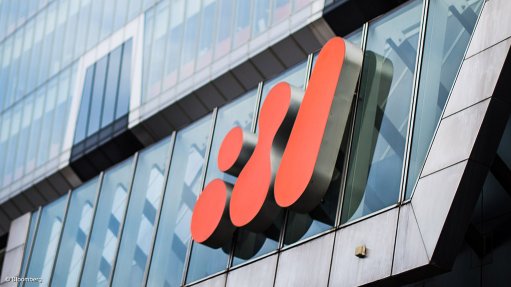
Photo by: Bloomberg
PERTH (miningweekly.com) – Planned maintenance work and natural field decline have resulted in mining major BHP reporting decreased production volumes across its portfolio for the quarter ended June.
Iron-ore production from the Pilbara was impacted by planned maintenance, resulting in a 3% decline in the September quarter production, compared with the June quarter, with BHP producing 61-million tonnes.
Petroleum production was also 1% lower in the September quarter, at 29-million barrels of oil equivalent, as the impact of Tropical Storm Barry was felt in the Gulf of Mexico, and planned maintenance at the North West Shelf, in Australia, impacted operations.
Copper production for the three months to September was down by 3%, to 430 000 t, owing to the planned maintenance related to the refinery crane at the Olympic Dam operation, in South Australia. This was partially offset by record concentrate throughput at the Escondida operation, in Chile.
“We delivered a solid start to the 2020 financial year through ongoing strong operational performance across our portfolio. While group production for the quarter decreased slightly due to the expected impacts of planned maintenance and natural field decline in petroleum, guidance remains unchanged and we are on track to deliver slightly higher volumes than last financial year,” said BHP CEO Andrew Mackenzie.
Metallurgical coal production for the quarter was also down 21%, to nine-million tonnes, while energy coal production was down 24%, to six-million tonnes, as planned maintenance and adverse weather conditions impacted operations.
Nickel production for the quarter was also down 25% from the June quarter, also reflecting the impact of planned maintenance and the transition to new orebodies.
Mackenzie on Thursday noted that all major development projects were tracking to plan, with the BHP board approving a $283-million investment for the development of the Ruby oil and gas project in Trinidad and Tobago.
The project consists of five production wells tied back using the latent capacity of the existing processing facilities, proven technology of the existing operated asset, and newly acquired ocean bottom node seismic imaging.
The project has estimated recoverable 2C resources of 13.2-million barrels of oil and 274-billion cubic feet of natural gas, and first production is expected in the 2021 calendar year.
At the end of the September quarter, BHP had six major projects under development in petroleum, copper, iron-ore and potash, with a combined budget of $11.4-billion over the life of the projects.
“The South Flank iron-ore project is 50% complete, with all our major projects on schedule and budget. We achieved further encouraging exploration results in petroleum and at the Oak Dam copper prospect,” Mackenzie said on Thursday.
The Jansen Stage 1 potash project, in Canada, will be presented to the board for final investment decision by February 2021.
In order to make a final investment decision, work on engineering to support project planning and on finalising the port solution is required, and the board has approved $144-million for these activities. An additional $201-million in funding was approved to further derisk the project, focussing on the mine’s scope of work, advancing other engineering and procurement activities, and preparation works for underground infrastructure.
This will enable an efficient transition of the project team between the study and execution phase, should the project be approved. The release of funding to the project will be staged over this period, Mackenzie said.